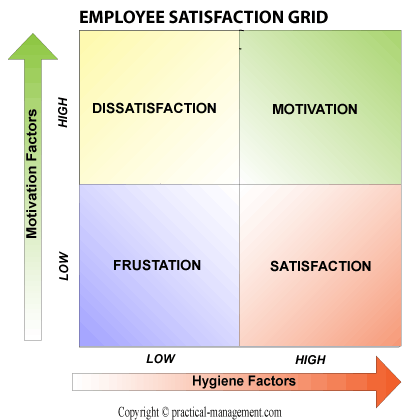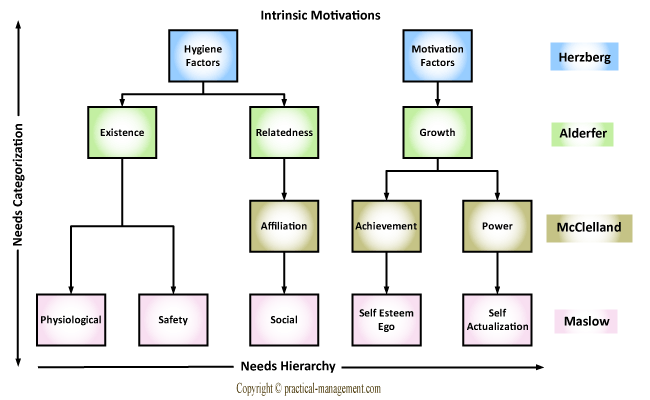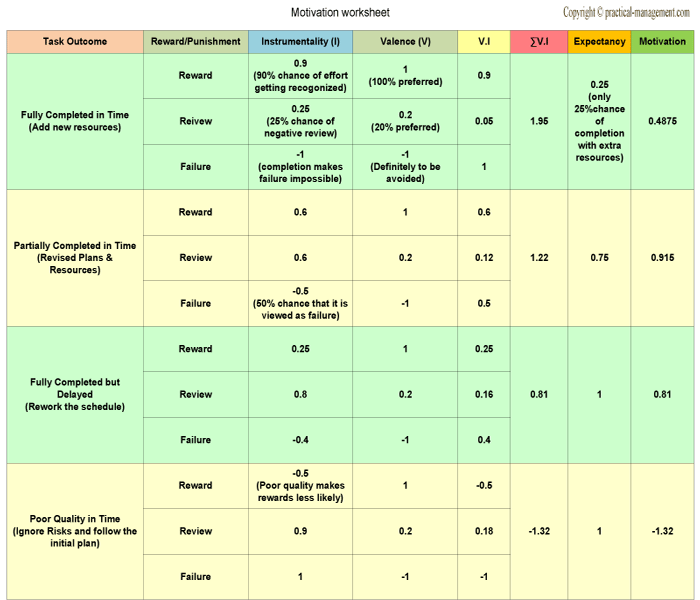What is employee motivation? This article describes the fundamental theories of employee motivation, intrinsic and extrinsic motivation and factors that influences them.
Employee Motivation
Motivation is a set of forces that directs an individual to the behavior that results in better job performance. A motivated employee might work harder than expected to complete the task, proactively find ways to improve the quality and efficiency of the work environment.
The key concepts of motivation are as follows
- Motivation is an inferred reason of an observed behavior. Although it can be directly measured by using various tools like surveys or 1-1 meetings, the reliability of such methods is questionable due to individual personality differences; the employee might not provide accurate feedback. Instead, we analyze the situations surrounding the individual, observe his response and then attempt to deduce the motivation responsible for the response.
- Two main components of motivation are the ‘direction’ of the behavior and its ‘intensity’. A positive direction refers to the act of choosing one of many choices that bring the individual closer to the goals.
- High motivation is a significant contributor to an exceptional performance. The effectiveness of an individual in an organization depends on few key factors, his ability to perform the assigned task, a healthy work environment and a reason that drives the individual to exceed the expectations. Skills and abilities can determine whether an employee is capable of performing a task. Deficiencies in skills can be managed by appropriate trainings, on the job coaching, matching the skills against different available tasks or roles; similarly the work environment can be improved by providing better resources and facilities. However, motivating employees is complicated since it depends upon individual needs, aspirations and core values; it is significantly more challenging compared to task or project management.
Needs – the fundamental ingredient of individual motivation
A need is something that an individual values and wants to achieve it. It is the basic foundation of a motivational framework. If an individual is devoid of needs, then it’s impossible to motivate him to perform any task.
- Deficiencies usually imply needs, however the continued effort required to keep the need satisfied is a need in itself.
- The needs can be categorized as following
- Physiological needs are related to physical well being of an individual such as need for food & shelter, need for medical care, insurance, disability assistance etc.
- Psychological needs refer to individual’s ego & self esteem, his intrinsic desire for achievement and power.
- Sociological needs refer to the desire of affiliation to a social group, the need to physically interact with other individuals.
Intrinsic Motivation
Intrinsic motivation focuses on factors that are inside a person and are based on individual needs. A self motivated person seeks to exceed expectation because he likes to perform the task; the work design matches the skill or expectation. Or he feels challenged by it; thereby its successful completion satisfies his ego and serves a purpose higher than the task itself. Motivating someone intrinsically implies leading the individual to a goal by satisfying the individual’s needs and values, instead of managing the project by offering transient rewards. One fundamental issue with intrinsic motivation is ability to identify the needs and to measure the effectiveness of the factors, since these factors are only inferred through observation of the reaction of the applied stimuli. This can be explained through individual differences, some individual might have more open and clear response, while others might be better at keeping the feelings to themselves.
Some of the classical need based theories are presented below, but instead of following the usual chronological order, they are presented in the order that makes their application more intuitive.
Hygiene-Motivators [Herzberg Theory]
Herzberg’s theory is known as two factor theory since it attempts to categorize the job related factors into hygiene factors and motivators.
- The Hygiene factors are the needs that are required for employee satisfaction and their elimination would certainly result in lack of motivation or dissatisfaction. However, even when they are adequately present, the employee’s level of motivation is only neutral. Hygiene factors are not directly
 related to the nature of the job, but are related to its derivatives, like salary, designation, job security, physical work environment and safety, HR policies, work schedule, paid leaves and interpersonal relationships.
related to the nature of the job, but are related to its derivatives, like salary, designation, job security, physical work environment and safety, HR policies, work schedule, paid leaves and interpersonal relationships. - The motivation factors are intrinsic to the job content and responsible for adding meaning to the work. It comprises of factors like feeling of achievement, prospects of career growth, increased responsibility and decision taking roles, interesting work, rewards and recognitions etc. It is important to understand that absence of motivation doesn’t lead to dissatisfaction, but their presence certainly causes satisfaction.
- Frustration: When the job is neither able to meet basic necessities nor offers any hope for future, the employees are bound to feel discouraged and depressed in their work.
- Dissatisfaction: The job promises a lot for the future but fails to provide a competitive salary or good work environment; the employee will be disillusioned and discontented with his job.
- Satisfaction: Although the job provides for basic necessities like good salary etc but only promises stability in long term association with the organization, the employee will most likely will be satisfied but not motivated to perform more than expected.
- Motivation: When both motivation factors and hygiene factors are adequately present in the job, the employee is highly motivated.
ERG Theory [Alderfer]
Alderfer’s theory categorizes the needs into three sets:
- Existence: The basic needs required for individual’s well being like working conditions, salary, etc. It is a sub-category of hygiene factors.
- Relatedness: It is the need to relate to other individuals, need for social communication and social identity. Again, this is a sub-category of hygiene factors since lack of social interaction will cause dissatisfaction. It is for this reason why teams and individuals working in different geographical locations need to be kept together through tools like telecommunication & video conferencing.
- Growth: It is analogous to the motivation factors in Herzberg theory when an individual’s self esteem is somehow satisfied.
The most important contribution of Alderfer’s theory is that if a higher order needs of an employee are not met, his lower order needs would become more important. Suppose the employee is unable to move to next level, perhaps due to company policies or nature of job, his priorities would regress and he would begin to expect more pay, more social interactions etc. Therefore a manager should try to divert the employee’s attention to relatedness or existence needs.
However, note that only growth need can be classified as motivational, thus regression to lower needs and their fulfillment will only raise the level of satisfaction from ‘frustration’ to ‘satisfaction’, but not to the level of motivation.
Learned Needs [McClelland]
McClelland believed that many needs are learned from the culture of the society, and are based upon the cultural and social values. Hence these are required for the social status of the individual. Following are the three learned needs:
- Need for Affiliation: It is analogous to relatedness and is a hygiene factor. Individuals with core personality type that depends highly on how they feel and are extrovert would have high desire of constant approval and appreciation of their task & ethics; thereby will have high need for affiliation.
- Need for Achievement: Individuals with high desire to accomplish goals and outperform their own previous records tend to have high need for achievement. Such individuals have some very peculiar characteristics, they expect immediate and specific feedback about their work since it helps them to track their own performance. To some degree, they are workaholic and tend to be preoccupied with their work even when they appear to be performing unrelated tasks. These individuals are self motivated and tend to assume personal responsibility for the successful completion of assigned task.
Interestingly, high achievement individuals fail to make good executive managers since they lack some crucial leadership traits. They are unable to delegate task to others, are uncomfortable with lack of immediate feedback, unable to take criticism and unable to evaluate risks correctly for the growth & survival of the organization. High achievement individuals tend to be comfortable within narrow range of moderate goals & risks, thus they lack ability to take appropriate decisions in crisis situations.
- Need for Power: These are individuals with high desire to control their environment and often exhibit strong leadership qualities. However, these individuals must seek power for betterment of organization, should have minimal need of affiliation since power implies alienation of others and must exercise self control when their personal preferences interfere with organizational goals.
Both need for achievement and power are strong motivational factors; affiliation can only be attributed with hygiene factor and helps in employee satisfaction.
Need Hierarchy [Maslow]
Maslow presented the first theory of needs and believed that employees would be motivated & satisfied if certain needs were met. He identified 5 major types of needs and formulated their hierarchal level such that lower order needs must be satisfied before higher order needs become important.
- Physiological Needs: These are basic biological needs necessary for survival as described earlier. According to Maslow, these are the lowest needs and should be satisfied first.
- Safety Needs: This second order need becomes important once biological needs are satisfied. The employee would look forward to physical safety in
 work environment, financial stability, retirement and disability benefits, life & health insurance etc. Also it includes psychological safety like job security, layoff compensation etc.
work environment, financial stability, retirement and disability benefits, life & health insurance etc. Also it includes psychological safety like job security, layoff compensation etc. - Social Needs: These are analogous to relatedness and need for affiliation, once both physiological & safety needs are satisfied, the employee would seek social activity in the organization.
- Ego Needs: These are needs for recognition and rewards; it is directly related to the growth need and is a major motivation factor. The organization can satisfy this need by promotion, change in designation, praise and public rewards, anything that can raise the level of employee’s self esteem and earns him respect in the organization.
- Self Actualization Needs: It refers to the desire to reach one’s maximum potential pertaining to knowledge, abilities and skills. This is the 5th and highest order need according to Maslow and can be related to need for achievement & power, growth and perhaps the highest form of intrinsic motivation.
Extrinsic Motivation
Extrinsically motivated individuals are indifferent to the nature of work but are motivated by external influences like rewards and prefer to avoid negative consequences. Extrinsic motivation is significantly important under several circumstances like routine & non-challenging tasks, limited career growth, stagnation in organization, individual differences etc; when managers need some way to motivate employees. Extrinsic motivations are formulated by observing how different stimuli or rewards cause a shift in behavior leading to successful satisfaction of predefined goals. Thus they are also termed as process-based theories since they are based on the process of how motivation occurs and can be applied along organizational dimensions.
Expectancy Theory
Expectancy theory of motivation was developed by Victor Vroom and it emphasizes that motivation is based on amount of effort required, the rewards or returns of the effort and the importance the individual gives to the rewards. Expectancy theory has four main components as described below.
- Outcomes are the consequences of the job related actions or behavior. For example, putting in extra hours [action] can result in early completion of task [outcome]. The outcomes are categorized into :-
- Job Related (first-level) – outcomes that directly impact the operations of the organizations, like timely deliveries, quality products, market reputation etc. These are the outcomes that the organization cares, values, measures and tracks.
- Employee Related (second-level) – outcomes that are rewards or punishment and are consequence of the job related outcomes. Timely completion of a task can result in promotion, pay benefit, bonus or failure to deliver can lead to performance review, rejection etc.
- Valence is the employee’s preference for the rewards or punishments, how much an employee values the consequences of the job related outcomes. It should be noted employee values what he receives for doing the job, while the organization values how well the job is done. When an outcome is preferred [rewards], valance is +1, when it is to be avoided [punishment], valance is -1. If the employee is indifferent to the outcome, then the valance is 0, e.g. doesn’t care about winning a ticket to baseball game.
- Instrumentality is the employee’s perception that job related outcome will lead to employee related outcome. It is measured as probability and is positively measured when task outcome is necessary for some reward/punishment, negatively measured when task outcome will make it harder to achieve reward/punishment. It is assumed to be 0 when reward/punishment is likely to occur irrespective of task outcome.
- Expectancy is the probability of achieving the task outcome with certain effort, it determines the perceived effort-outcome relationship - how hard it is to achieve the outcome?
Expectancy theory formulates the motivation of a particular task outcome using the three components in the following formula:
Motivationtask = Etask x ∑(I x V)employee related
Where Etask is the effort-outcome expectancy of the task, I & V are instrumentality and valance of the all the employee related outcomes of the job related task outcomes.
To understand how this formulation works, consider a project scenario in which it a risk is identified that can jeopardize the quality and features of the product. It is not possible to follow the current plan and meet the delivery deadline. The project manager has several choices as shown in the fig and each choice can result in recognition, a review to access if the best actions were taken or the project can be deemed as a failure.
Interestingly, partially completed but on schedule outcome has the highest motivation in this example. 
Tips for practicing expectancy theory
- Set realistic goals which can be perceived as achievable by the employees, else the expectancy will be very low, leading to low motivation. Assign the job based on the skill, experience and abilities of the employee or teams.
- Determine the employee preferences for the rewards; it should be something that they value. In a group setting, the individual preferences are equally important and attempt to arrive at a common value might discourage some members.
- Determine how the rewards/punishment can be used to attain the organizational goals and values, it might include budget constraints, organizational cultural values etc.
- Use rewards rather than punishment, punishment has only short term effect but discourages workers for a longer period, on the contrary it creates an environment of confrontation with the management where employees view it as a challenge to find new ways to break rules and get by.
Equity Theory
Equity theory states that the employee motivation level is dependent on the perception of being fairly treated for the task related efforts, when compared with other employees. The three main components of equity theory are:
- Inputs are the elements that the employee contributes for the job. Primary elements are time, effort, skill, experience, education, efficiency etc. The secondary elements, though cannot be directly attributed to the job but are essential to the employee, it includes long commute to work, extra expenditure on child care etc.
- Outputs are the elements that the employee receives for doing the job. The primary elements are pay, benefits like pay, bonus, medical & life insurance, rewards & recognition, professional memberships etc. The secondary elements are job experience, professional network, a social environment of the office etc.
- Inputs/output ratio: The employee subconsciously evaluates the return on their invested effort or inputs/outputs ratio. Then they try to compare the same for the individuals in their peer network.
The equity exists if their own input/output ratio is comparable to that of their peers in the professional network. If however their ratios are lower than others, then they become dissatisfied and would be motivated to seek ways to attain equity. It should be noted that equity is perceptional in nature and is subjective since employees have little factual data to support their claim of the inputs/outputs ratio of the others. This is often the reason why any discussion with management on being unfairly treated only leads to more dissatisfaction and devoid of any agreement.
Possible actions to restore equity
Dissatisfied employee can undertake few different ways to restore equity, all require altering the inputs & outputs till the ratios are equitable.
- Reducing inputs – employee might decide to put less effort into the job by taking more time to finish the tasks, reducing the reliability & quality of the tasks, refrain to take additional roles and responsibilities etc.
- Pursuing higher outputs – confronting the management for high pay & benefits.
- Influencing others to alter their input/outputs – the employee might get indulged in office politics, deliberately misguide others, be very critical of their performance, refuse to cooperate with others, create unnecessary dependencies to decrease their productivity etc.
- Quit & change Job – the employee might perceive the current work environment and its culture to be hopeless and might choose to quit the current job in pursuit of finding a better, more equitable work environment.
